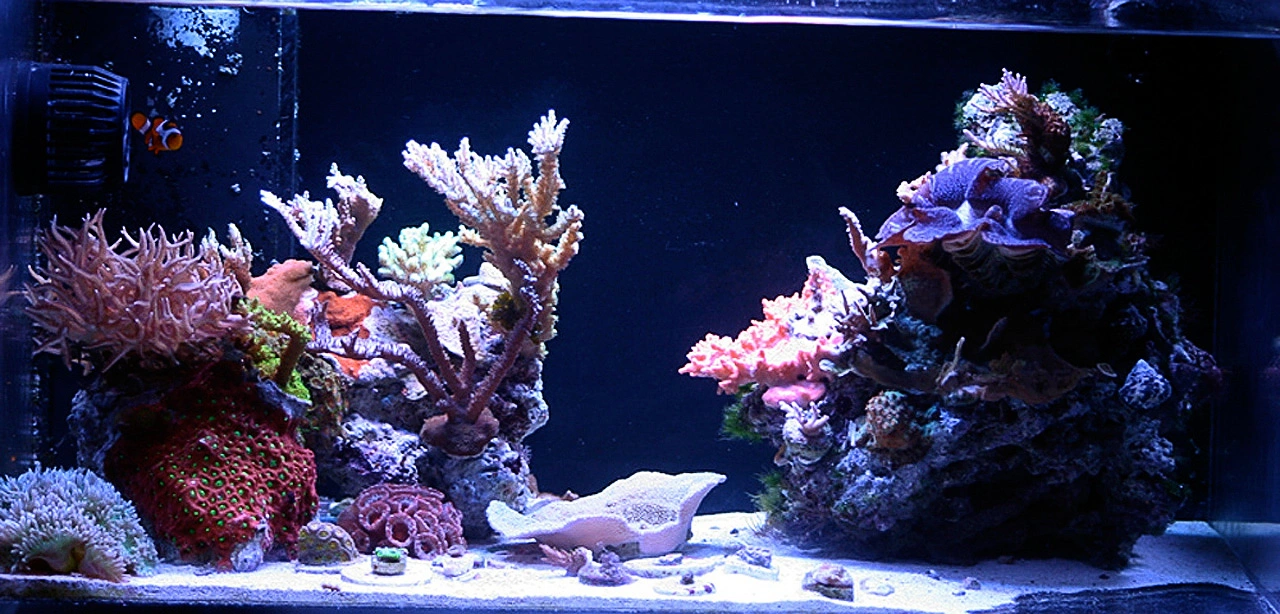Stunning 35-Gallon Reef Tank – DaveFason's TOTM | NanoReef

Tank Specifications
Volume: 35 Gallons / 132 Liters
Dimensions (L × W × H):
30.0" ×
18.0" ×
15.0"
76.2cm ×
45.7cm ×
38.1cm
Equipment List
- Salt: Instant Ocean
Frequently Asked Questions
What kind of lighting is recommended for a nano reef tank?
For a nano reef tank like a 35-gallon setup, consider using a combination of T5 lighting and LED fixtures. The owner utilizes an ATI Sunpower 24'' fixture along with a Nano Box LED Fixture, which provides excellent coverage and allows for control over the light spectrum, essential for coral growth.
How often should I change the activated carbon in my reef tank?
It is advisable to change activated carbon every 2 to 3 weeks. This helps maintain water quality by removing toxins, discoloration, and other unwanted substances.
What type of skimmer should I use for my reef tank?
Investing in a good quality skimmer is crucial for maintaining a healthy reef tank. The iTech 100 Skimmer mentioned is highly effective for removing excess nutrients and keeping the water clear.
How often should I perform water changes, and how much should I change?
For a 35-gallon reef tank, perform a 5-gallon water change every two weeks. This routine helps refresh the water and replenish essential elements.
How can I prevent calcium deposits from clogging my pumps?
To prevent calcium build-up in your pumps, conduct a vinegar bath on your return and circulation pumps once a month. Soaking them will dissolve any calcium deposits and keep them functioning properly.
What is the best way to monitor and maintain water parameters?
Regularly test your water parameters, including salinity, ALK, and calcium levels. Use reliable tools like a digital refractometer for salinity and periodic test kits for other parameters. Maintain a regular dosing schedule as needed.
What types of corals are suitable for a nano reef tank?
In a nano reef tank, it's ideal to choose hardy corals like Acropora, Montipora, and Zoanthids, as well as LPS corals like Favia and Acan. These species can offer stunning visuals while generally being resilient to fluctuations.
How frequently should I feed my fish and corals?
Feed your fish 3 to 4 times daily using high-quality options like Rods frozen food and Spectrum Pellets. For corals, allow natural feeding through water flow rather than direct feeding to promote a natural feeding process.
My tank water looks cloudy; what should I do?
Cloudy water could be a sign of bacterial blooms or excess nutrients. Ensure your skimmer is working effectively, and consider doing a water change. Testing for ammonia and nitrite levels is also wise to rule out other causes.
What should I do if I notice calcium precipitation in my tank?
If you experience calcium precipitation, check your dosing and water parameters immediately. It may help to lower dosing temporarily and monitor closely for any changes in your corals and overall tank health.